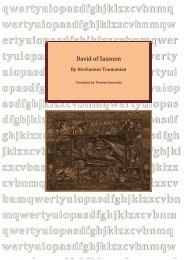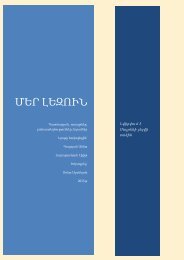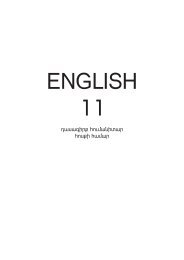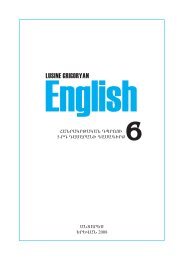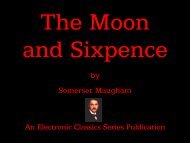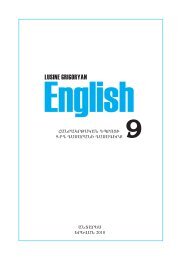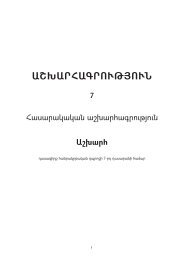Focus on Words
Focus on Words
Focus on Words
You also want an ePaper? Increase the reach of your titles
YUMPU automatically turns print PDFs into web optimized ePapers that Google loves.
. natural orders:<br />
c. expositi<strong>on</strong>/the introducti<strong>on</strong>, body, the c<strong>on</strong>clusi<strong>on</strong>, climax.<br />
d. plot - a sequence of events. The plot centers round a problem/<br />
c<strong>on</strong>flict.<br />
e. the characters (the main character) the speech of the characters may<br />
be presented in the form of a m<strong>on</strong>ologue or a dialogue.<br />
f. summary of the book<br />
g. the story line: love/adventure/emergency/embarrassing situati<strong>on</strong>;<br />
reas<strong>on</strong>s for likes/dislikes/ disappointment; the plot - dull/interesting/<br />
c<strong>on</strong>fusing/thrilling, etc.<br />
h. describing a piece of literature<br />
books: adventure books, a novel’, a drama, a short- story, poetry, prose, poem,<br />
biography, memories, fantasy, science ficti<strong>on</strong>, detective story, modern/classical/<br />
ancient, literature<br />
descripti<strong>on</strong>: to open up, depict, describe, true to life, picture, illustrate, design, write<br />
about, portray, reveal<br />
author: poet, dramatist, playwright, story-teller; prolific/distinguished/brilliant/wellknown<br />
volume: page, chapter, publish, edit, editi<strong>on</strong>, character, hero, heroine.<br />
i. The purpose of the essay is<br />
describe, persuade, discuss, explain, analyse, compare, evaluate<br />
Style tips for narratives<br />
1. Use the opening paragraph to get the reader’s attenti<strong>on</strong>.<br />
2. Do not just report the facts, but describe the setting of the story, and add in some<br />
details that make it easier for the reader to imagine what the situati<strong>on</strong> was like.<br />
3. In the following two or three paragraphs, describe how the story unfolds.<br />
4. Use adjectives and adverbs to make your narrati<strong>on</strong> more imaginative. Use varied<br />
vocabulary and sentence structure. 5.D<strong>on</strong>’t forget to help the reader understand the<br />
protag<strong>on</strong>ists’ emoti<strong>on</strong>s.<br />
5. To create tensi<strong>on</strong>, change the rhythm of the language by sometimes using l<strong>on</strong>g<br />
sentences and sometimes very short <strong>on</strong>es. (But make sure that your sentences are<br />
not too l<strong>on</strong>g!)<br />
6. Look at the extract underlined in the story as an example.<br />
7. In the final paragraph, round off the story. Say what the experience meant to you<br />
pers<strong>on</strong>ally.<br />
119





